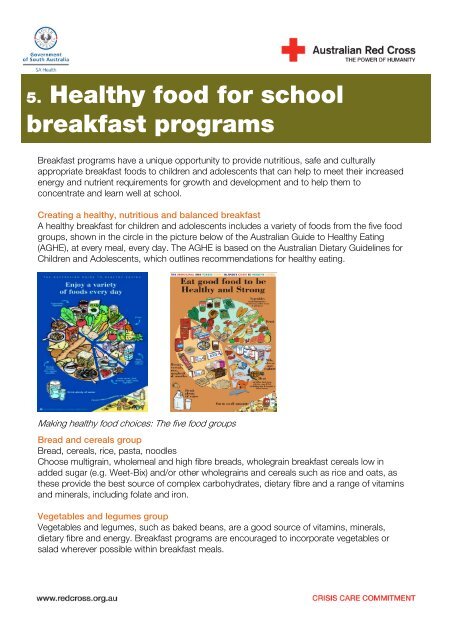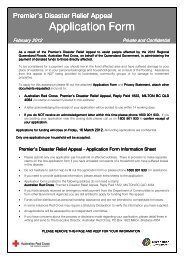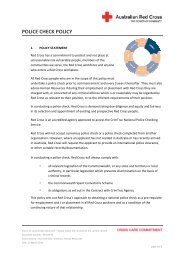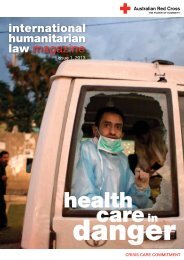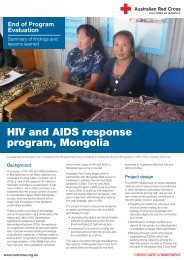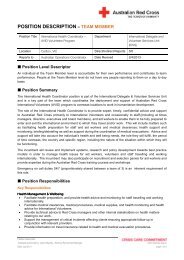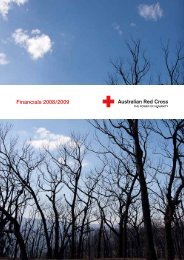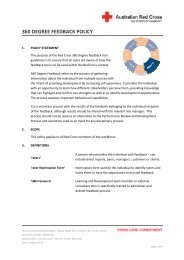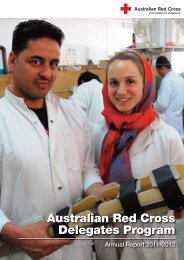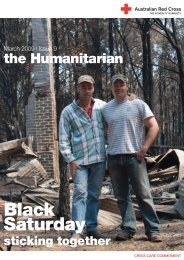5. Healthy food for school breakfast programs - Australian Red Cross
5. Healthy food for school breakfast programs - Australian Red Cross
5. Healthy food for school breakfast programs - Australian Red Cross
Create successful ePaper yourself
Turn your PDF publications into a flip-book with our unique Google optimized e-Paper software.
<strong>5.</strong> <strong>Healthy</strong> <strong>food</strong> <strong>for</strong> <strong>school</strong><strong>breakfast</strong> <strong>programs</strong>Breakfast <strong>programs</strong> have a unique opportunity to provide nutritious, safe and culturallyappropriate <strong>breakfast</strong> <strong>food</strong>s to children and adolescents that can help to meet their increasedenergy and nutrient requirements <strong>for</strong> growth and development and to help them toconcentrate and learn well at <strong>school</strong>.Creating a healthy, nutritious and balanced <strong>breakfast</strong>A healthy <strong>breakfast</strong> <strong>for</strong> children and adolescents includes a variety of <strong>food</strong>s from the five <strong>food</strong>groups, shown in the circle in the picture below of the <strong>Australian</strong> Guide to <strong>Healthy</strong> Eating(AGHE), at every meal, every day. The AGHE is based on the <strong>Australian</strong> Dietary Guidelines <strong>for</strong>Children and Adolescents, which outlines recommendations <strong>for</strong> healthy eating.Making healthy <strong>food</strong> choices: The five <strong>food</strong> groupsBread and cereals groupBread, cereals, rice, pasta, noodlesChoose multigrain, wholemeal and high fibre breads, wholegrain <strong>breakfast</strong> cereals low inadded sugar (e.g. Weet-Bix) and/or other wholegrains and cereals such as rice and oats, asthese provide the best source of complex carbohydrates, dietary fibre and a range of vitaminsand minerals, including folate and iron.Vegetables and legumes groupVegetables and legumes, such as baked beans, are a good source of vitamins, minerals,dietary fibre and energy. Breakfast <strong>programs</strong> are encouraged to incorporate vegetables orsalad wherever possible within <strong>breakfast</strong> meals.
<strong>5.</strong><strong>Healthy</strong> <strong>food</strong> <strong>for</strong> <strong>school</strong><strong>breakfast</strong> <strong>programs</strong>An example of <strong>food</strong>s and drinks to provide in a <strong>breakfast</strong> program<strong>Healthy</strong> cereal options include Weet-Bix, Vita Brits, untoasted muesli, porridge or oats. Topwith fresh or tinned fruit and/or reduced fat fruit yoghurt. See how many <strong>food</strong> groups you canget into one bowl!Other healthy options <strong>for</strong> <strong>breakfast</strong> include:• Yogurt and fruit, or a fruit smoothie with low fat milk and yoghurt• Poached or boiled eggs with wholegrain toast and reduced fat milk or a small glass of fruitjuice• Fruit salad topped with flavoured reduced fat yoghurt• Pancakes topped with fruit and yoghurt• Wholegrain or wholemeal toast is a healthy option and can be topped with:Poached, boiled or scrambled eggsPeanut butter (check <strong>school</strong> policy), ricotta cheese, avocado, fruit spread orvegemite<strong>Red</strong>uced salt baked beans<strong>Red</strong>uced fat cheese and vegetables such as tomato, mushroom, avocado andspinachLean ham or sliced chicken• For variety wholegrain toast can be replaced by wholegrain crumpets, fruit bread, <strong>breakfast</strong>muffins, rice cakes, pita bread or mountain bread.<strong>Healthy</strong> eating in the <strong>school</strong> environmentBreakfast <strong>programs</strong> in <strong>school</strong>s are encouraged to refer to the in<strong>for</strong>mation and guidelinesprovided by the Right Bite <strong>Healthy</strong> Food Supply Strategy <strong>for</strong> SA Schools and Pre<strong>school</strong>s andthe DECS <strong>Healthy</strong> Eating Guidelines <strong>for</strong> <strong>school</strong>s and pre<strong>school</strong>s. Relevant websites are listedbelow.References<strong>Australian</strong> Guide to <strong>Healthy</strong> Eating, 1998:http://www.health.gov.au/internet/main/publishing.nsf/Content/health-pubhlth-strateg-<strong>food</strong>guide-index.htmDietary Guidelines <strong>for</strong> Children and Adolescents in Australia, 2003:http://www.nhmrc.gov.au/_files_nhmrc/file/publications/synopses/n30_pamphlet.pdfRight Bite Strategy and <strong>Healthy</strong> Eating Guidelines: www.decs.sa.gov.au/rightbite SA Health(2009), SA Community Foodies Training Manual, Internal Document


